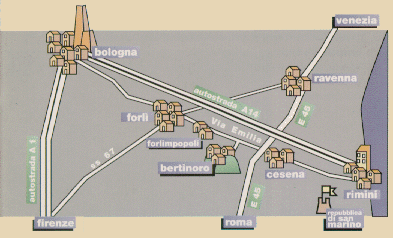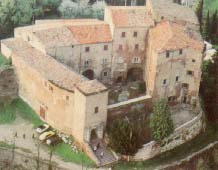

Introduction
Lecture Plan
Summary
Lectures, Units and Topics
Teachers
Location
Organising Committee
Participant Details
Bulletin Board
Photos
Final Report
MONET Summer School - May 15-19 2000, Bertinoro, Italy
The MONET summer school on Model-Based Systems and Qualitative Reasoning (MBS/QR) was held at the University Residential Centre of Bertinoro (Italy) on May 15-19, 2000 (Monday 09:00 until Friday 17:00).
The Summer School took place in the University Residential Centre of Bertinoro. The Centre, built inside the age old Stronghold and its fortified walls, has been operating since June 1994 as the seat of University training courses, of national and international meetings and congresses as well as qualifying cultural events.
Further details of location
Introduction
The goals of the Summer School were:
- To inspire and prepare the next generation of researchers in the field of MBS/QR.
- To convey to young industrialists the potential of MBS/QR technology for solving problems resulting from interacting with complex systems and their behaviour.
- To communicate the type of problems that can be solved by applying MBS/QR technology.
- To present a coherent and comprehensive overview of the main results and achievements of MBS/QR research.
- To layout the state of the art of MBS/QR technology, highlight problems and open issues, and point out the research opportunities for the near future.
Lecture Plan (Subject to minor changes)
Monday 15 Tuesday 16 Wednesday 17 Thursday 18 Friday 19 Morning Welcome A1 A3 A4 A5 B5 B6 (unit 1) Afternoon A2 B1 Soc. B3 B6 (unit 2) B2 B4 B7 Closing
Lectures, Units and Topics (Subject to minor changes)
Three hour lectures
A three hour lecture consisted of 3 units. Each unit lasts one hour, including a 15 min break between units.Lecture A1: Introduction to Qualitative Modelling and Simulation
(Teacher: Ken Forbus )
- unit A1.1: motivation
(Slides PPT HTML )
- problems, principles, ideas and theories/approaches
- what is the role of simulation (prediction/postdiction)
- QR/MBS history
- unit A1.2: qualitative model(ling)(s)
(Slides PPT HTML )
- ontologies for simulation models
(components, processes, constraints, functional models, etc.)
- quantities, qualitative values and quantity spaces
- dependencies
(influences, proportionalities, inequalities, etc).
- basic concept of qualitative calculus
(incl. the notion of ambiguity)
- unit A1.3: model construction and simulation
(Slides PPT HTML )
- model fragments
- qualitative states, state transition and simulation
- properties: completeness, soundness
(incl. demos)
Lecture A2: Advanced Topics in MBS/QR
(Teacher: Unit A2.1 & A2.3 Ken Forbus and Unit A2.2 Peter Struss)
- unit A2.1: causality
(Slides PPT HTML )
- causality (what is meant by it?)
- causality as a basis for prediction and explanation
- techniques for causal ordering
- unit A2.2: advanced qualitative calculus
(Slides PPT HTML )
- qualitative calculus
- order of magnitude reasoning
- interval reasoning
- unit A2.3: modelling paradigms
(Slides PPT HTML )
- compositional modelling
- abstractions (time scale, parameter)
- points of view (behavioral, functional, etc.)
Lecture A3: Model-Based Diagnosis
(Teacher: Luca Console)
(Slides PPT HTML )
- unit A3.1: introduction and motivation
- overview of diagnostic approaches / problems
(rule-based, functional, causal models etc., should lead to the conclusion: MBD is a specific type of diagnosis)
- why model-based ?
(what are the special features, why is it better)
- component-connection model
- consistency-based diagnosis
(basic steps including: detecting discrepancies, conflict generation, candidate generation, and probing)
- unit A3.2: multiple and large scale models
- fault models
(including elaboration on: consistency versus abductive diagnosis)
- multiple (fault) models, structural models, hierarchical models dealing with large scale models
- unit A3.3: examples, non-technical domains and remaining problems
- applications and examples
- MBD in non-engineering/technical domains
- remaining problems and future research goals
(e.g. bridge-faults, time varying faults)
Lecture A4: Qualitative Reasoning and Educational Systems
(Teacher: Bert Bredeweg)
- unit A4.1: introduction and motivation
(Slides PPT HTML )
- overview on research on cognition and learning (brief)
(highlight notions such as: novice/expert distinction, common sense reasoning, analogical reasoning)
- why use simulation models?
(what are the benefits, how are they used, methods of teaching)
- relevance of articulate models (in ILE)
- unit A4.2: teaching functions in Interactive Learning Environments (ILE)
(Slides PPT HTML )
- diagnosing learner behaviour
- generating explanations
- visualisation of simulation models/results
- model progression
- unit A4.3: examples and remaining problems
(Slides PPT HTML )
- CSCL and other WWW related issues
- applications and examples
- remaining problems and future research goals
Lecture A5: Qualitative and Semi-Quantitative Simulation
(Teacher: Ben Kuipers)Two hour lectures
- unit A5.1: modeling and simulation with incomplete knowledge
(Slides PPT HTML )
- introduction and motivation
- Qualitative Differential Equations and qualitative behavior:
the QSIM representation
- Qualitative Simulation
(incl. constraint filtering, behavior filters, behavior abstraction)
- research problem/question
- unit A5.2: semi-quantitative simulation
(Slides PPT HTML )
- partial quantitative knowledge, semi-quantitative differential equations
- semi-quantitative simulation: Q2, Q3, NSIM
- semi-quantitative system identification
- open research problems
- unit A5.3:
(Slides PPT HTML )
- abstraction methods that help make qualitative simulation tractable
- temporal logic methods that make it possible to query the results of qualitative simulation automatically (rather than inspecting them by hand)
A two hour lecture consists of 2 units. Each unit lasts for one hour, including a 15 min break between units.Lecture B1: Model-based Diagnosis in the Automotive Industry
(Teacher: Peter Struss)
(Slide 1 PPT HTML )
(Slide 2 PPT HTML )
(Slide 3 PPT HTML )
(Slide 4 PPT HTML )
(Slide 5 PPT HTML )
(Slide 6 PPT HTML )
- unit B1.1: introduction, motivation and problems
- what are the characteristics of the task and/or domain
- what are the problems (in terms of the domain and/or task)
- what are the challenges for the MBS/QR technology
- problems and solutions
- unit B1.2: examples and remaining problems
- problems and solutions (cont'd)
- applications and examples
- future (research) goals
Back to Top Lecture B2: Model-based Reasoning in Ecology Domains
(Teacher: Peter Struss)
(Slide 1 PPT HTML ZIP )
(Slide 2 PPT HTML )
- unit B2.1: introduction, motivation and problems
- what are the characteristics of the task and/or domain
- what are the problems (in terms of the domain and/or task)
- what are the challenges for the MBS/QR technology
- problems and solutions
- unit B2.2: examples and remaining problems
- problems and solutions (cont'd)
- applications and examples
- future (research) goals
Lecture B3: Model-based Reasoning for Control tasks & Medical applications
(Teacher: Unit B3.1 Ben Kuipers and Unit B3.2 Liliana Ironi)
- unit B3.1 Model-based reasoning for control tasks
(Slides PPT HTML )
- introduction
- examples of control: feedback, adaptive, integrated control
- overview of conventional control approaches and their limitations
- motivations for qualitative/model-based reasoning for control
- unit B3.2: QR and medical applications
(Slides PPT HTML )
- how might medical reasoning/tasks benefit from QR
- modeling ontologies for pathophysiological systems
(compartmental modeling)
- which level of representation
(pure qualitative, semi-quantitative, quantitative) versus tasks
examplesLecture B4: Diagrammatic Reasoning and
Visualisation of System Behaviour
(Teacher: Alan Blackwell)
(Slides PPT HTML )
- unit B4.1: introduction and motivation
- what are the problems
- overview on research in this area
(problems and solutions)
- unit B4.2: examples and remaining problems
- problems and solutions (cont'd)
- applications and examples
- future research goals
Lecture B5: Qualitative Reasoning and Mathematical Modeling
(Teacher: Liliana Ironi)
- unit B5.1 quantitative modeling
(Slides PPT HTML )
- introduction: what is mathematical modeling, what are the problems
(physical and numerical accuracy)
- integration of qualitative and quantitative approaches to deal with:
- automated structural modeling (qualitative analysis of experimental data, QR for delimiting the search model space, QR for the choice of proper numerical methods and their possible initialization)
- non-parametric/black-box modeling (QR for the initialization of a proper identifier scheme)
- brief overview of qualitative-quantitative integrated approaches and tools
- unit B5.2 a case study
(Slides PPT HTML )
- Automated modeling of visco-elastic materials and its use for the assessment of physico-chemical properties of drug-delivery systems
Lecture B6: Knowledge Management using MBS/QR Technology
(Teacher: Andy Steele)
- unit B6.1: introduction and motivation
- what are the issues?
(to enable organisations to compete effectively in emerging knowledge economy; can help represent qualitative/heuristic/tacit knowledge in easy-to-understand structured format, thus enabling sharing and re-use of valuable corporate and industrial knowledge)
- overview on research in this area
(problems and solutions, e.g.: qualitative influence diagrams for physical or business process modelling)
- unit B6.2: examples and remaining problems
- problems and solutions (cont'd)
- applications and examples (success stories?)
- future research goals
Lecture B7: Qualitative Spatial Reasoning and Kinematics
(Teacher: Tony Cohn)
(Slides PPT HTML )
- unit B7.1: introduction, motivation and problems
- what are the problems
- overview on research in this area
(problems and solutions)
- unit B7.2: examples and remaining problems
- problems and solutions (cont'd)
- applications and examples
- future research goals
Teachers
Teachers were senior researchers and experienced users with a wide range of insights. They were able to present clearly the main ideas, point out problems, discuss outstanding issues, and reflect on the area as a whole. Teachers were encouraged to stay around during the whole summer school and mingle with participants, so that they were available for in-depth discussion and questioning by students.List of Teachers
Alan Blackwell
Computer Laboratory
University of Cambridge
Cambridge, UK
Bert Bredeweg
Department of Social Science Infomatics (SWI)
Universiteit van Amsterdam
Amsterdam, The Netherlands
Tony Cohn
School of Computer Studies
University of Leeds
Leeds, UK
Luca Console
Dipartimento di Informatica
Universita' di Torino
Torino, Italy
Ken Forbus
Institute for the Learning Sciences
Northwestern University
Evanston, Illinois, USA
Liliana Ironi
Istituto di Analisi Numerica (CNR)
Pavia, Italy
Ben Kuipers
Department of Computer Sciences
The University of Texas at Austin
Austin, Texas, USAAndy Steele
Unilever
London, UK
Peter Struss
Department of Computer Science
Technical University of Munich
Munich, GermanyLocation
The Summer School took place in the University Residential Centre of Bertinoro.

Bertinoro is half way between Forlė and Cesena, 6 kilometres from State Road No.9 (Via Emilia), immediately east of Forlimpopoli.
For details of how to reach the Centre, see the Centre's "How to Reach Us" page (http://www.spbo.unibo.it/bertinoro/ecomeraggiungerci.html)
You may find the "Ferrovie dello Stato" (Italian Railway) web site useful for train timetables etc.Organising Committee
Bert Bredeweg
Department of Social Science Infomatics (SWI)
Universiteit van Amsterdam
Amsterdam, The Netherlands
Liliana Ironi
Istituto di Analisi Numerica (CNR)
Pavia, Italy
Louise Trave-Massuyes
LAAS/CNRS
Toulouse, France
